Editor's Note:  Thomas A. Mierzwa, P.E., is a civil-structural engineerfor LWG Consulting Inc.'s northeast region.
Thomas A. Mierzwa, P.E., is a civil-structural engineerfor LWG Consulting Inc.'s northeast region.
In the event of a tornado, hurricane, or severe tropical storm,the potential for damage to nearby buildings and civil structuresis significant. This potential increases with various factors, suchas the proximity of the storm event to the structure, age,construction quality, engineering, and materials used inconstruction.
|For hurricanes and tropical storms, for example, structuresalong the coastline are at greater risk than structures builtinland. The reason is there can be a substantial wind component ontop of tidal surge and flooding that must be taken intoconsideration. For inland structures, the strength of the wind andtidal surges are less from hurricanes and tropical storms eventhough flooding can still result from heavy rainfalls. Tornadoesmostly impact inland structures in areas deemed to be at higherrisk through analyzing historical weather patterns.
|Loss Severity
After these occurrences,damage to structures can range from a total loss to no damage atall except that the concerned policyholder believes his or herproperty may have sustained damage.
Buildings that have been demolished by such a catastrophic eventmay not leave clues from which the claims adjuster or engineer candetermine what portion of the storm resulted from wind/waterinfiltration compared to flooding. Most structural forensic work isto structures that are around 50-percent damaged to no damage atall.
|A claims adjuster may find the insured structured demolished,while neighboring structures remain intact and suffer minimaldamage. Why is this? Could there be a construction defect thatallowed the wind and/or flood to damage the structure? Certaininvestigate tips and research can help claims professionalsaccurately answer these types of questions.
|Pre-Existing Conditions
For wind-relatedevents to buildings, the first questions that should be raisedare:
How fast was the wind?
Answers can befound through common weather-related Web sites and the NationalOceanic and Atmospheric Administration (NOAA). It is important touse several different weather stations that encompass the subjectproperty, and either average the data or use conservative values.
How old is the structure?
Thisquestion is relevant because an older structure may not sustain theimpact of high winds as well as a newly constructed building. Asbuilding codes become more defined, loading conditions for wind andsnow have generally increased.
For example, a new building along the coast may be designed for120-mph winds, whereas a 40-year-old building may have only had tobe designed for 80-mph winds. Sometimes, though, the exact oppositeis true. Sometimes older buildings sustain less damage while newer(and commonly lighter) buildings sustain more damage. This isbecause of the use of bigger, thicker materials (which are oftenheavier) that can help restrict the movement of a structure.
|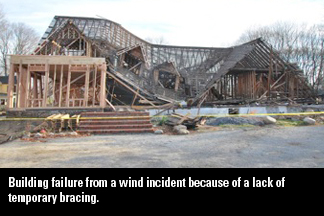 Where is the damage observed? Thisquestion should be answered (when dealing with wind-relatedmatters) from the top down. Generally speaking, wind affectsbuildings the higher they stand off the ground, possibly leavingblown-off roofs and no observed damage to first-floor walls or thefoundation. Lighter gauged materials such as roof vents, shutters,and roof coverings along the roof perimeter and ridges willgenerally show more damage than along the inner face.
Where is the damage observed? Thisquestion should be answered (when dealing with wind-relatedmatters) from the top down. Generally speaking, wind affectsbuildings the higher they stand off the ground, possibly leavingblown-off roofs and no observed damage to first-floor walls or thefoundation. Lighter gauged materials such as roof vents, shutters,and roof coverings along the roof perimeter and ridges willgenerally show more damage than along the inner face.
How was the buildingconstructed?
Most wood-framed buildings usecommon roof lumber that generally have provisions that must be metto ensure the building does not get blown down. Hurricane clips,straps, and anchors are utilized along the roof-to-wall,wall-to-wall, wall-to-floor, and floor-to-foundation connections.Any of these areas missing possible load-transfer provisions mayresult in damage caused from a wind incident that could haveotherwise been prevented.

If a building is under construction when a loss occurs, thenthere are usually provisions and codes in force to protect thebuilding while it is under construction. The general contractor istypically responsible for protecting the structure to preventpossible damage. The use of temporary bracing and methods toprotect against the elements is a major component to ensurefailures do not occur.
|An example of this condition has been noticed after a tornadooccurred in an area that does not experience tornadoes. Because ofthe lack of tornadoes, some contractors and building officials maynot have been as concerned in ensuring these conditions are met. Ina particular development that was constructed using severaldifferent contractors, some common themes developed where certainbuildings sustained more damage than others standing closer to thetornado path.
|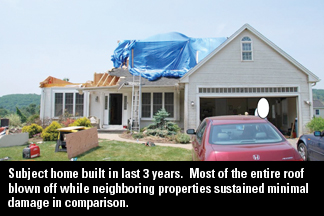 Other inspections of the neighboring properties indicatedthat hurricane clips and straps were utilized, as indicated below,which help minimize the overall structural damage.
Other inspections of the neighboring properties indicatedthat hurricane clips and straps were utilized, as indicated below,which help minimize the overall structural damage.
The end result may aid in the insurer's decision to possiblypursue subrogation against the contractor or builder for failure toinstall these clips, which would have prevented the building frombeing an almost total loss.
|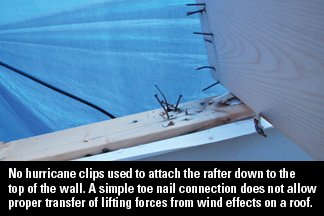
The aftereffects of a hurricane can lead to difficultassessments and may include segregating damage that was caused bywind and water infiltration. While damage to roof areas is commonlyattributable to wind, areas along the first and second floors couldbe damaged by wind/water and/or flooding/tidal surges that couldaffect the overall scope and cost of the claim.
|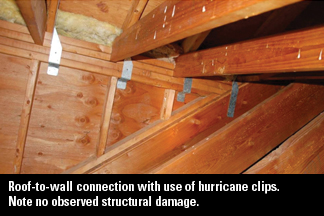 Weather-related losses are another area where a civilengineer can greatly assist with claims investigations. Thewreckage from a catastrophic hurricane can devastate whole citiesand cost insurers and reinsurers hundreds of millions of dollars.The common question tends to be what damage was caused by wind andrain and what damage was caused by flood. A civil engineer canprovide a site inspection documenting crucial information to helpdistinguish between the damages.
Weather-related losses are another area where a civilengineer can greatly assist with claims investigations. Thewreckage from a catastrophic hurricane can devastate whole citiesand cost insurers and reinsurers hundreds of millions of dollars.The common question tends to be what damage was caused by wind andrain and what damage was caused by flood. A civil engineer canprovide a site inspection documenting crucial information to helpdistinguish between the damages.
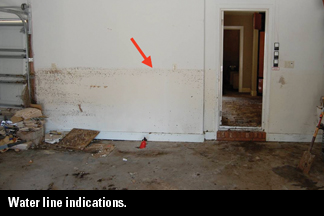 Water-mark lines along building walls, trees, and hillsshould always be inspected. Impact strikes indicative of objectscrashing around during a tidal-surge period are major indicators offlood damage. Usually, wind damage affects weaker materials such asvinyl siding and asphalt-shingled roofs. Wind forces are strongestalong building corners and edges and can damage structures fromboth a positive and negative (vacuum) pressure. If a building isentirely leveled without anything left to inspect, then a civilengineer can also estimate damage that could have been caused bywind, rain, and flooding based on storm weather data andflood-survey maps.
Water-mark lines along building walls, trees, and hillsshould always be inspected. Impact strikes indicative of objectscrashing around during a tidal-surge period are major indicators offlood damage. Usually, wind damage affects weaker materials such asvinyl siding and asphalt-shingled roofs. Wind forces are strongestalong building corners and edges and can damage structures fromboth a positive and negative (vacuum) pressure. If a building isentirely leveled without anything left to inspect, then a civilengineer can also estimate damage that could have been caused bywind, rain, and flooding based on storm weather data andflood-survey maps.
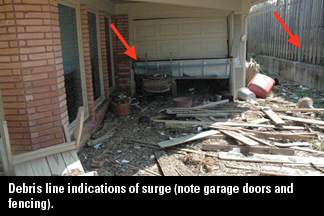
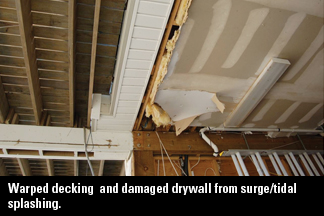
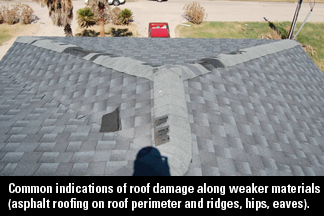
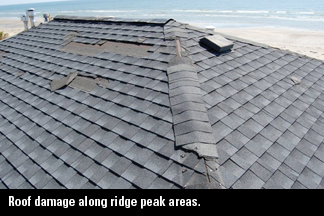 Tell-Tale Signs of Wind VersusWater
Tell-Tale Signs of Wind VersusWater
The following tips can be used tohelp evaluate the overall damage and indicate if the cause isprimarily wind/water intrusion or surge:
- Determine and document any evidence of mold:Upper floors may indicate the point of entry from wind/waterintrusion. Bathroom areas may indicate prior indication of amoisture/humidity problem from venting.
- Examine the sheetrock in the interior of thebuilding and note distressed areas of the sheetrock (upper floorsmay indicate wind and/or surge if cracking is throughout).
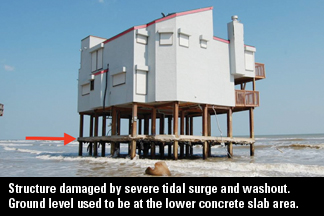 Warping damage on floors and opened up ceilingsfrom below (can indicate surge).
Warping damage on floors and opened up ceilingsfrom below (can indicate surge).- Warping flooring around base of windows mayindicate water intrusion.
- Identify how high the water was in the home.Look for high water marks on walls or debris lines around theproperty or adjacent structures (indicates surge).
- Identify the home's base flood elevation (fromFEMA) and overall ground elevation (which can indicate overallflood/water levels within the home).
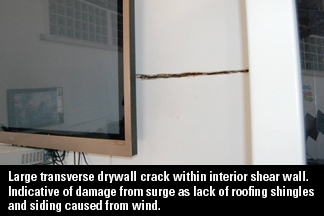 When structural damage is suspected, a civil engineer candetermine if a foundation crack was caused by constructionactivities by visually observing within the cracks for details suchas the color, sharp edges, the presence of any dust, debris, and/orpaint. Additionally, a civil engineer will inspect for evidence ofbuilding settlement, soil conditions, and temperature changeswithin building materials, as well as examining pre-constructiondamage surveys and seismographs.
When structural damage is suspected, a civil engineer candetermine if a foundation crack was caused by constructionactivities by visually observing within the cracks for details suchas the color, sharp edges, the presence of any dust, debris, and/orpaint. Additionally, a civil engineer will inspect for evidence ofbuilding settlement, soil conditions, and temperature changeswithin building materials, as well as examining pre-constructiondamage surveys and seismographs.
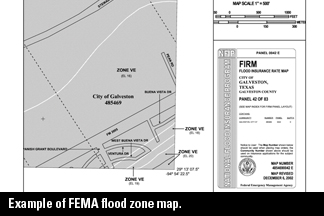
Want to continue reading?
Become a Free PropertyCasualty360 Digital Reader
Your access to unlimited PropertyCasualty360 content isn’t changing.
Once you are an ALM digital member, you’ll receive:
- All PropertyCasualty360.com news coverage, best practices, and in-depth analysis.
- Educational webcasts, resources from industry leaders, and informative newsletters.
- Other award-winning websites including BenefitsPRO.com and ThinkAdvisor.com.
Already have an account? Sign In
© 2024 ALM Global, LLC, All Rights Reserved. Request academic re-use from www.copyright.com. All other uses, submit a request to [email protected]. For more information visit Asset & Logo Licensing.








